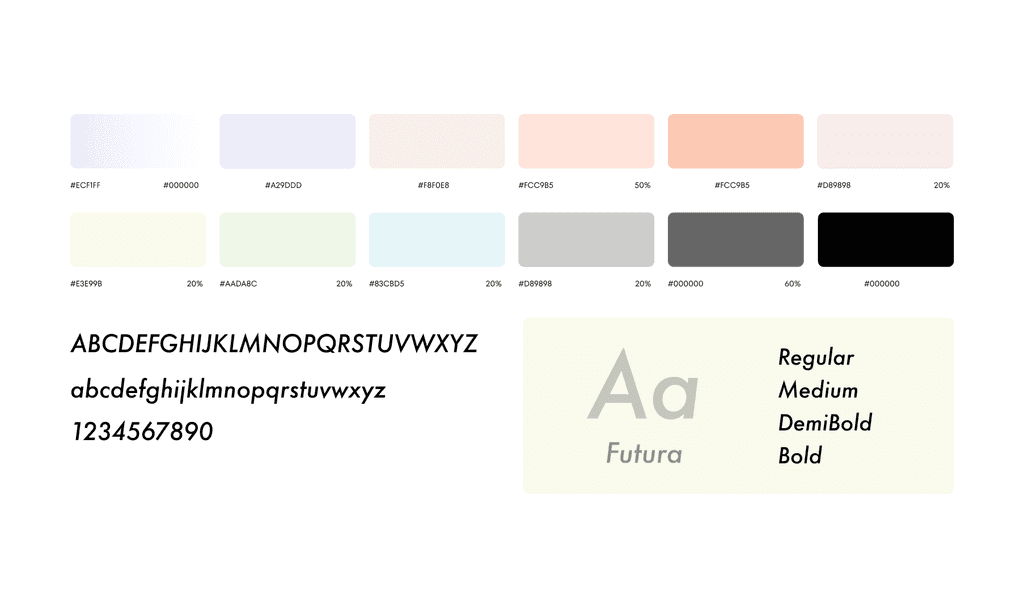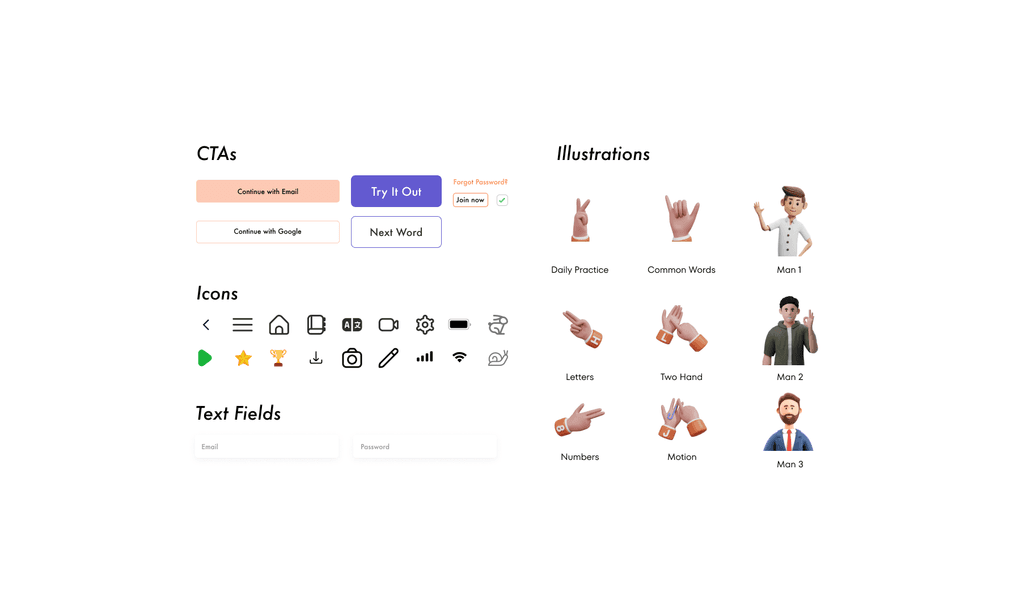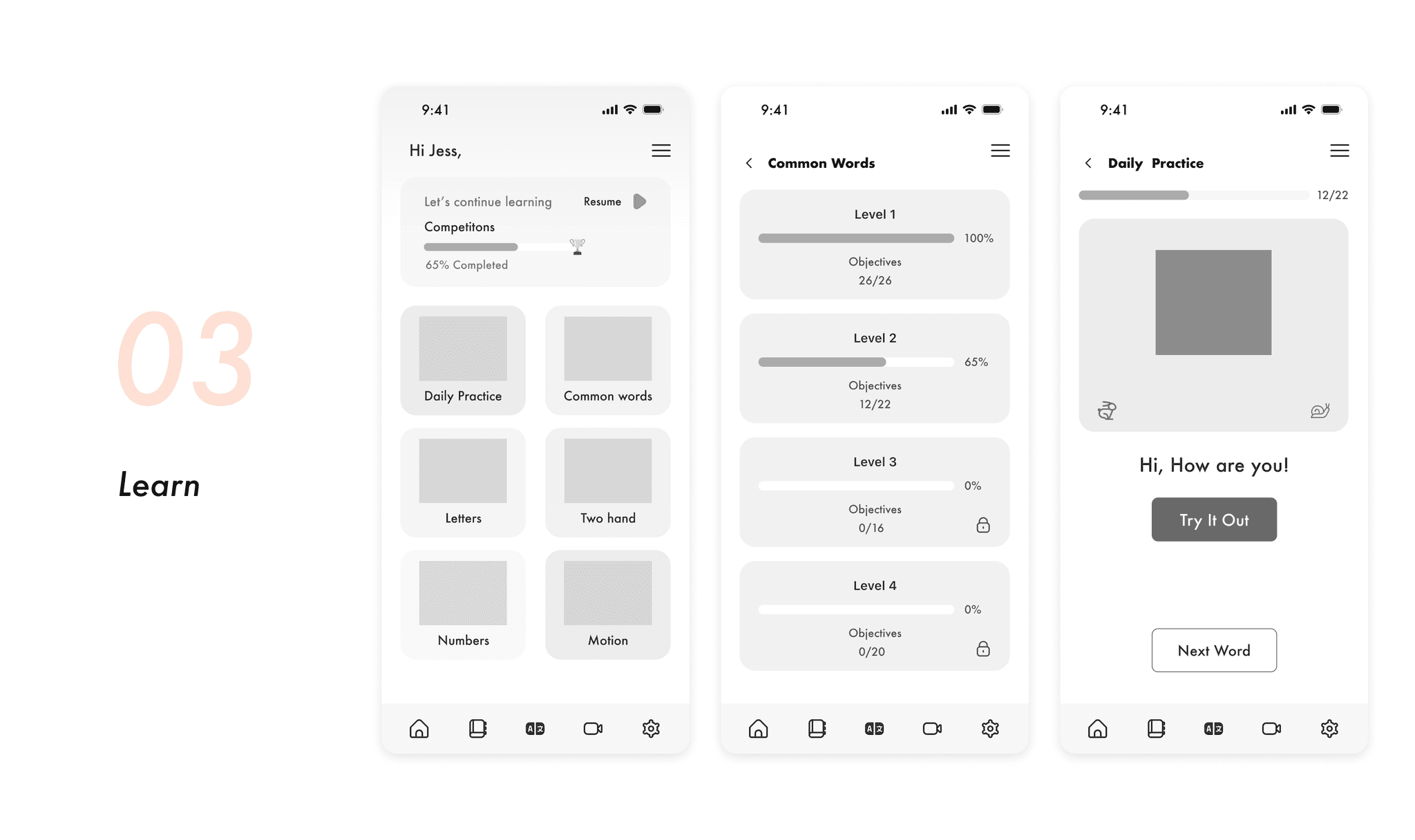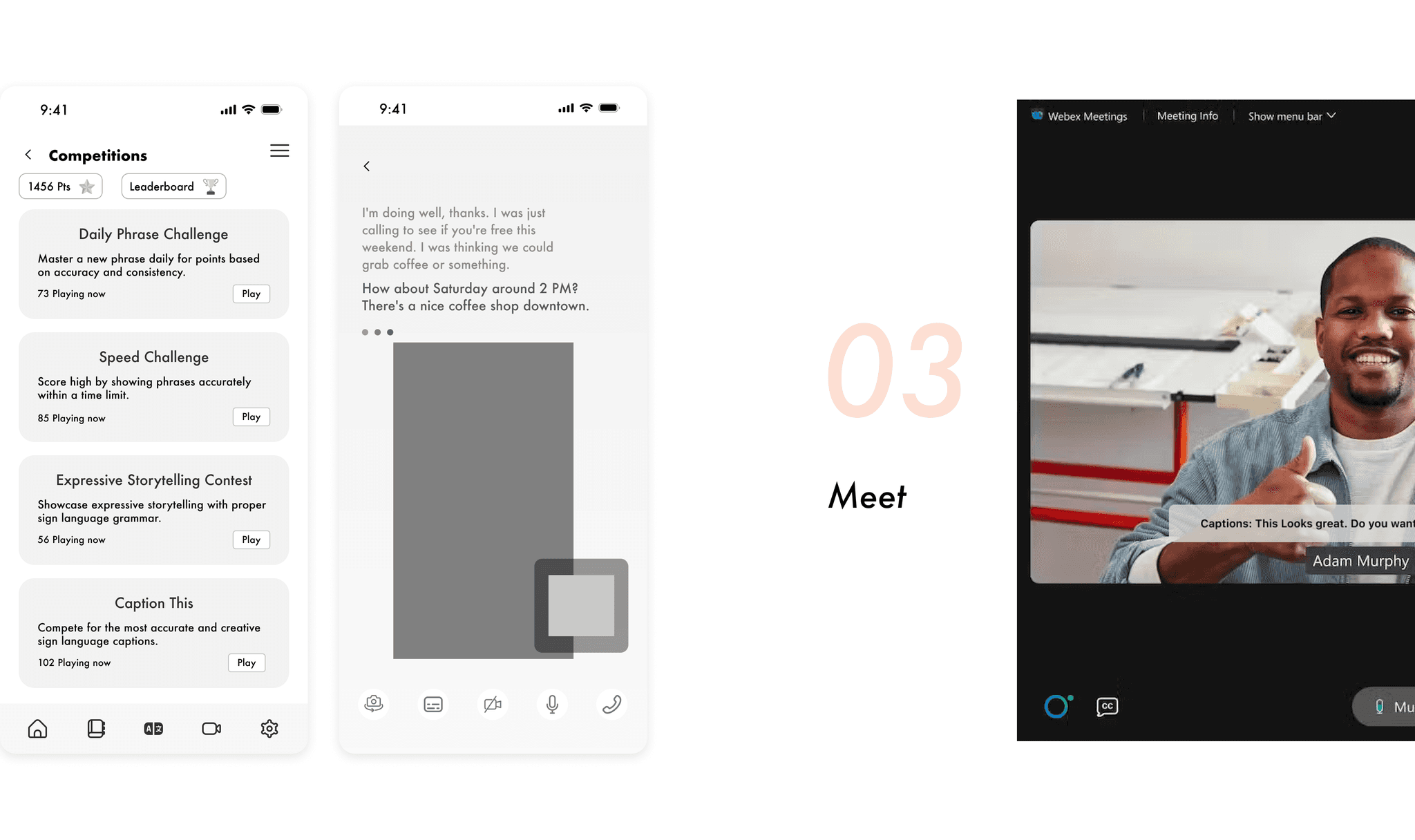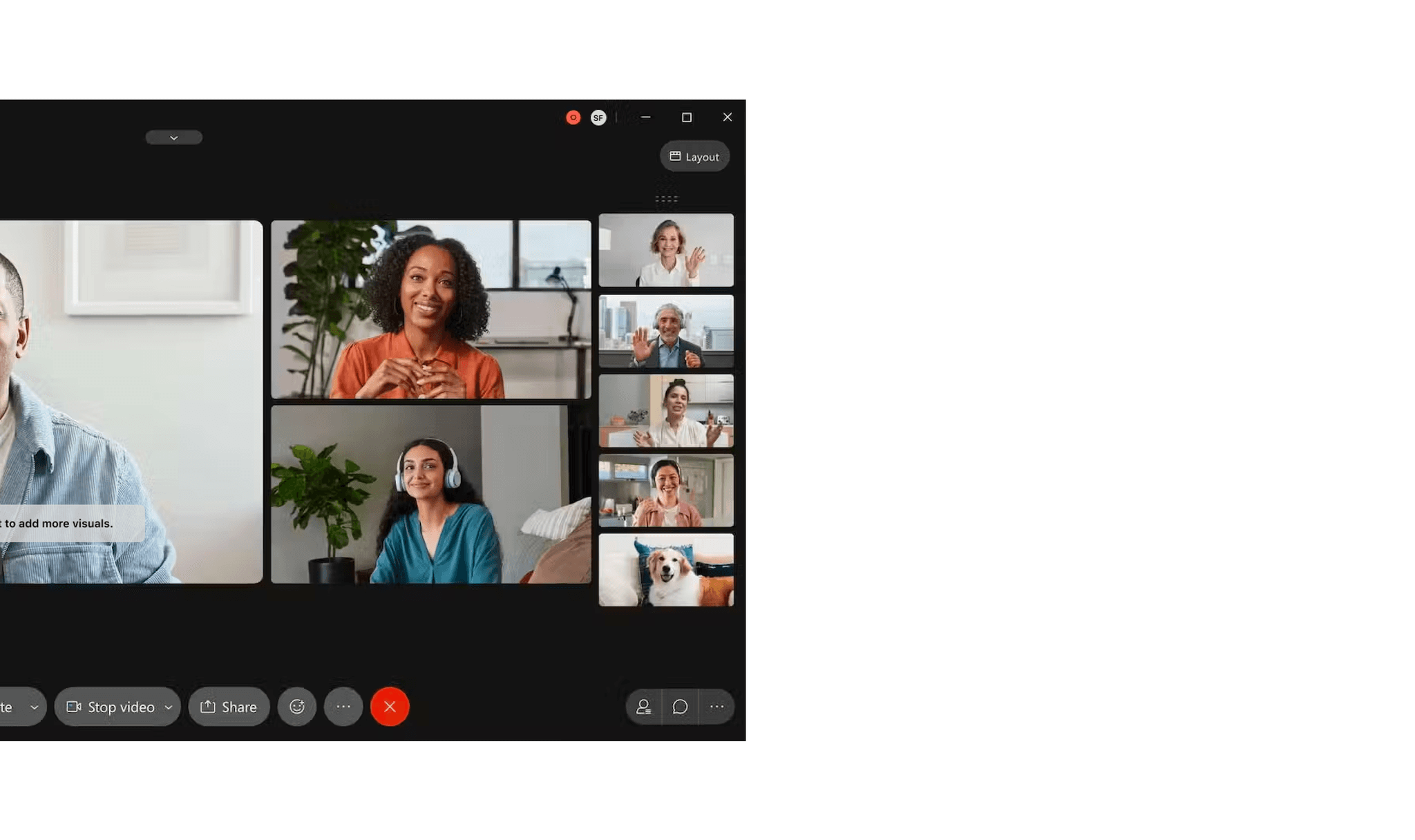App Design | Accessibility
App Design | Accessibility
SignFlow: Making multilingual signs feel like one voice
SignFlow: Making multilingual signs feel like one voice
Overview
Overview
In a world with over 300 sign languages and millions relying on non-verbal communication, the act of understanding each other isn’t always seamless.
Signflow is our response — a mobile-first product that empowers deaf and hard-of-hearing individuals to communicate, learn, and connect across sign language barriers.
In a world with over 300 sign languages and millions relying on non-verbal communication, the act of understanding each other isn’t always seamless.
Signflow is our response — a mobile-first product that empowers deaf and hard-of-hearing individuals to communicate, learn, and connect across sign language barriers.
My Role
My Role
Product Designer
Product Designer
Duration
Duration
12 weeks | Fall 2023
12 weeks | Fall 2023
Team
Team
4 Designers + Researchers
4 Designers + Researchers
My Contribution
My Contribution
UX Research · Visual Design · UX Writing · Competitive Analysis · System Mapping · Communication Strategy
UX Research · Visual Design · UX Writing · Competitive Analysis · System Mapping · Communication Strategy

Problem Discovery
Problem Discovery
People who sign still struggle to understand each other
People who sign still struggle to understand each other
Despite sign language being a powerful tool of expression for millions, there is no universal standard. With over 300 distinct systems and limited app support, users often face fragmentation, miscommunication, and isolation — even when they sign. Most tools support only one language, lack real-time translation, or fail to engage diverse learners. This disconnect raised a key question:
Despite sign language being a powerful tool of expression for millions, there is no universal standard. With over 300 distinct systems and limited app support, users often face fragmentation, miscommunication, and isolation — even when they sign. Most tools support only one language, lack real-time translation, or fail to engage diverse learners. This disconnect raised a key question:
HMW bridge fragmented sign languages to enable seamless connection?
HMW bridge fragmented sign languages to enable seamless connection?
Our Solution - SignFlow
Our Solution - SignFlow
An interactive, learner-first, and connection-driven take on sign language communication.
An interactive, learner-first, and connection-driven take on sign language communication.
Platform that empowers you to communicate, learn, and connect with people from all walks of life.
Translate
Translate
Two signers. Two different languages. One seamless translation.
Two signers. Two different languages. One seamless translation.
Real-time sign-to-text translation using camera-based AI.
Enables face-to-face communication without third-party interpreters.
Automatically generates transcripts for easy access to past conversations.
Real-time sign-to-text translation using camera-based AI.
Enables face-to-face communication without third-party interpreters.
Automatically generates transcripts for easy access to past conversations.
Lack of cross-sign communication → Real-time sign-to-sign translation
Learn
Learn
A parent learning to sign, one daily goal at a time.
A parent learning to sign, one daily goal at a time.
Bite-sized lessons for easy, everyday learning
Progress bars to visualize growth and milestones
Streaks to build daily learning habits
“Try it Out” camera-based practice for real-time gesture feedback
Social leaderboards and learning buddies to stay motivated and connected
Bite-sized lessons for easy, everyday learning
Progress bars to visualize growth and milestones
Streaks to build daily learning habits
“Try it Out” camera-based practice for real-time gesture feedback
Social leaderboards and learning buddies to stay motivated and connected
Learning fatigue is real → Gamified, goal-driven sign language learning
Meet
Meet
From hand gestures to on-screen text, making remote connections accessible.
From hand gestures to on-screen text, making remote connections accessible.
Live sign-to-text translation during video calls for real-time captions.
Reduces reliance on interpreters, ensuring privacy and on-demand accessibility.
Cross-platform plugin support for tools like Zoom and Google Meet.
Scalable for enterprise and education, without needing to use the main app.
Live sign-to-text translation during video calls for real-time captions.
Reduces reliance on interpreters, ensuring privacy and on-demand accessibility.
Cross-platform plugin support for tools like Zoom and Google Meet.
Scalable for enterprise and education, without needing to use the main app.
Desire for multimodal support → Live captioning of sign language during video calls
Design Process
Design Process
Researching Problem Space
Researching Problem Space
Turning Constraints into Clarity
Turning Constraints into Clarity
Given the lack of access to real users, we anchored our approach in deep secondary research, competitive analysis, and system-level insights. This allowed us to uncover existing gaps, understand patterns of user frustration, and identify opportunities grounded in real-world needs.
Given the lack of access to real users, we anchored our approach in deep secondary research, competitive analysis, and system-level insights. This allowed us to uncover existing gaps, understand patterns of user frustration, and identify opportunities grounded in real-world needs.
Discover
→
→
Define
→
→
Ideate
→
→
Design
→
→
Reflection
Defining Persona & Goals
Defining Persona & Goals
Consolidating our key insights into 2 goal-oriented personas.
Consolidating our key insights into 2 goal-oriented personas.


28 · International Student · Fragmentation
28 · International Student · Fragmentation
Wants to communicate with others who use different sign languages, especially in global or travel scenarios.
Struggles with the lack of real-time, cross-sign translation tools.
Wants to communicate with others who use different sign languages, especially in global or travel scenarios.
Struggles with the lack of real-time, cross-sign translation tools.


42 · Parent of a Deaf Child · Urgency
42 · Parent of a Deaf Child · Urgency
Needs to quickly learn sign language to connect with their child and support everyday conversations.
Feels overwhelmed by the lack of simple, motivating learning tools.
Needs to quickly learn sign language to connect with their child and support everyday conversations.
Feels overwhelmed by the lack of simple, motivating learning tools.


19 · College Student & Hobbyist · Engagement
19 · College Student & Hobbyist · Engagement
Loves signing and wants to expand fluency beyond ASL through interactive, gamified learning.
Often disengages due to static, non-personalized learning apps.
Loves signing and wants to expand fluency beyond ASL through interactive, gamified learning.
Often disengages due to static, non-personalized learning apps.
Why This Matters
Why This Matters
70 million+
people use sign language as their primary language.
70 million+
people use sign language as their primary language.
91.89%
satisfaction was observed in gamified learning apps for deaf children, showing the need for engaging interfaces.
91.89%
satisfaction was observed in gamified learning apps for deaf children, showing the need for engaging interfaces.
Despite rapid tech advancement, no current app supports live, cross-sign communication + learning + social connection in one experience.
Despite rapid tech advancement, no current app supports live, cross-sign communication + learning + social connection in one experience.
Analyzing Market & Competitions
Analyzing Market & Competitiors
Competitive benchmarking revealed an oversaturated market competing on identical feature sets.
Competitive benchmarking revealed an oversaturated market competing on identical feature sets.
We began by anchoring our design process in human-centered research, ensuring that every feature of Signflow is a response to a real barrier faced by our users.
We began by anchoring our design process in human-centered research, ensuring that every feature of Signflow is a response to a real barrier faced by our users.
HandTalk
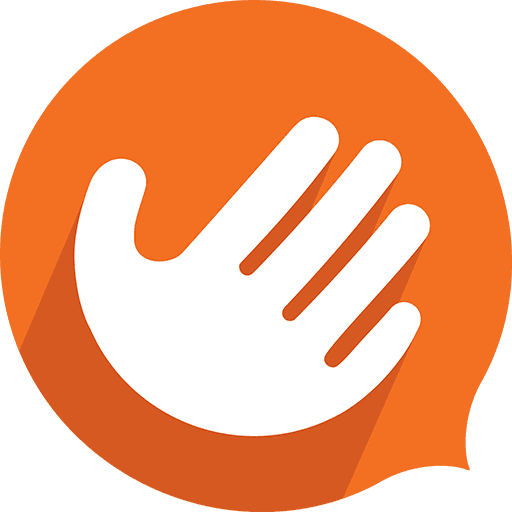
Pros
Real-time translation.
Movement recognition technology for enhanced digital accessibility.
Interaction and information access.
Cons
Primarily focus on Portuguese and Libras, limiting its utility.
Requires specific device capabilities.
Jeenie

Pros
Connects users with HIPAA-trained interpreters.
Serves various industries.
Real-time support provided.
Cons
Live interpreters is not always feasible or cost-effective.
Support not always be guaranteed depending on on time zones & availability.
ASL Pocket Sign

Pros
Video lessons, Dictionary, and activities to learn ASL.
Suitable for a wide range of users.
Convenient go-to learning and practicing tool.
Cons
Lack of real-time interaction or feedback.
Limited content scope as it only focuses on ASL.
“Most existing systems don’t cater to people fluent in multiple sign languages — they force users to juggle apps or settle for subpar translations.”
“Most existing systems don’t cater to people fluent in multiple sign languages — they force users to juggle apps or settle for subpar translations.”
Feature Prioritization
Feature Prioritization
Shaping the MVP Around What Users Need Most.
Shaping the MVP Around What Users Need Most.
With limited time and no direct user access, we prioritized features based on impact vs. effort. The goal was to focus the MVP on low-effort, high-impact solutions — especially those addressing key persona pain points. This prioritization was shaped through desk research insights, cross-functional workshops, and persona mapping, ensuring we built what mattered most, first.
With limited time and no direct user access, we prioritized features based on impact vs. effort. The goal was to focus the MVP on low-effort, high-impact solutions — especially those addressing key persona pain points. This prioritization was shaped through desk research insights, cross-functional workshops, and persona mapping, ensuring we built what mattered most, first.


The Solution: Signflow
The Solution: Signflow
New Information Architecture
New Information Architecture
Competitive benchmarking revealed an oversaturated market competing on identical feature sets.
Competitive benchmarking revealed an oversaturated market competing on identical feature sets.
We tried to create a robust sign language app that integrates various sign languages and advanced features for improved accessibility and engagement.
We tried to create a robust sign language app that integrates various sign languages and advanced features for improved accessibility and engagement.
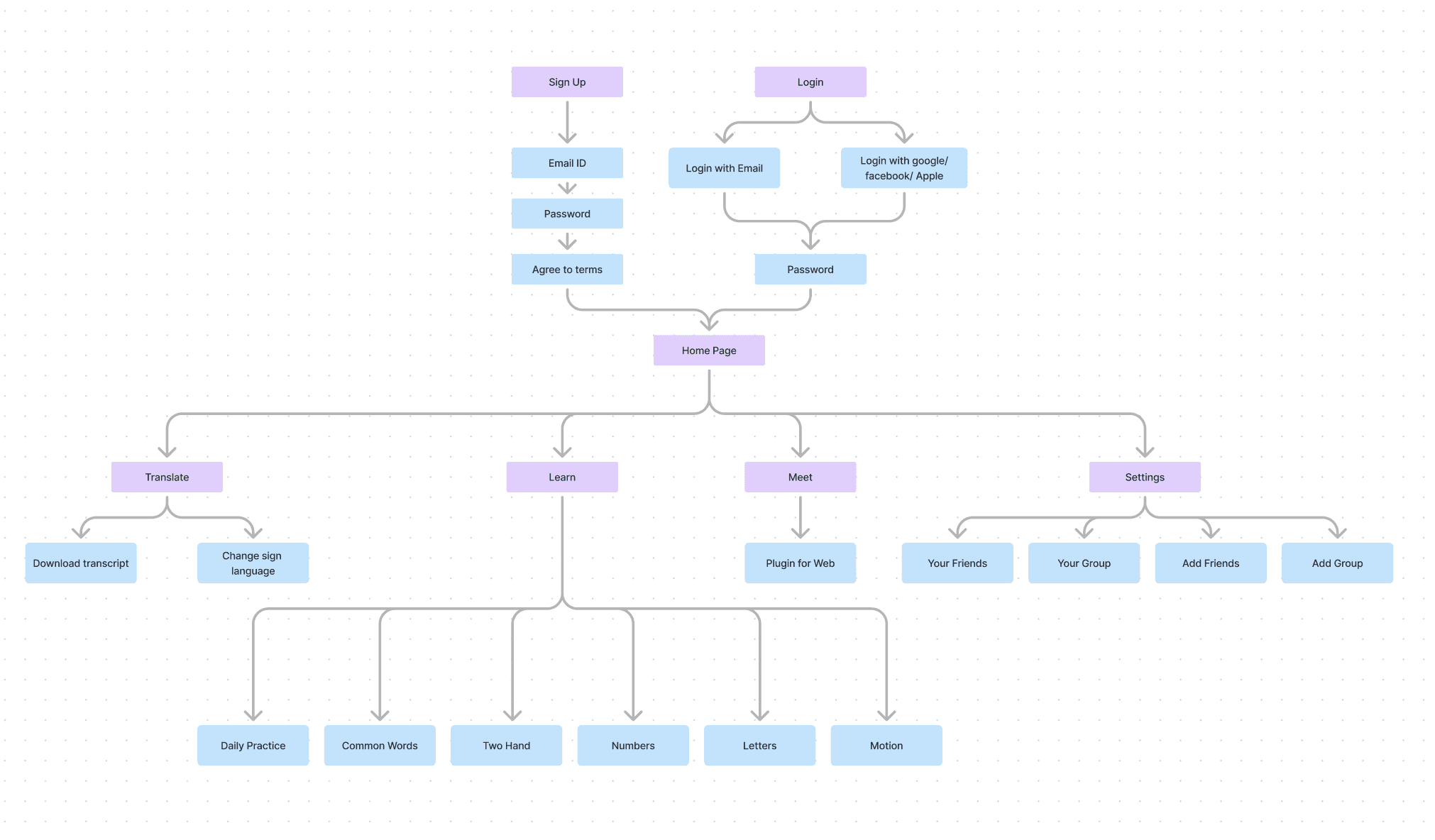

Accessibility + Visual Design
Accessibility + Visual Design
Designing for Clarity, Consistency, and Access
Designing for Clarity, Consistency, and Access
We created a modular UI library grounded in inclusive design — with high-contrast visuals, minimal text dependency, and motion-based interaction. We also explored customizable language settings and AR-compatible translation prototypes for future scalability. Each component was built to support clarity and ease across diverse user needs, making the experience feel intuitive and empowering for all.
We created a modular UI library grounded in inclusive design — with high-contrast visuals, minimal text dependency, and motion-based interaction. We also explored customizable language settings and AR-compatible translation prototypes for future scalability. Each component was built to support clarity and ease across diverse user needs, making the experience feel intuitive and empowering for all.
Wireframing
Wireframing
Sketching the Flow of Connection
Sketching the Flow of Connection
We built mid-fidelity wireframes that reflected our personas’ needs and scenarios — like a parent trying to learn quickly, or a deaf user needing instant translation during a conversation. Each screen was designed to support accessibility, emotional clarity, and task ease, without overwhelming first-time users.
We built mid-fidelity wireframes that reflected our personas’ needs and scenarios — like a parent trying to learn quickly, or a deaf user needing instant translation during a conversation. Each screen was designed to support accessibility, emotional clarity, and task ease, without overwhelming first-time users.
Challenges & Future Directions
Challenges & Future Directions
Limitations
Limitations
The current prototype is limited to hand gesture recognition (misses facial expression & body language nuances).
Android-first approach excluded iOS users (to be expanded).
Plugin support for third-party platforms still needs to be tested.
The current prototype is limited to hand gesture recognition (misses facial expression & body language nuances).
Android-first approach excluded iOS users (to be expanded).
Plugin support for third-party platforms still needs to be tested.
Future Enhancements
Future Enhancements
Multimodal input: gesture + facial expression + lip reading.
Offline accessibility in low-internet regions.
Multilingual subtitle overlay for mixed hearing/signing conversations.
Multimodal input: gesture + facial expression + lip reading.
Offline accessibility in low-internet regions.
Multilingual subtitle overlay for mixed hearing/signing conversations.
Impact & Learnings
Impact & Learnings
“Signflow isn’t just an app — it’s an attempt at making global conversations inclusive by default.”
“Signflow isn’t just an app — it’s an attempt at making global conversations inclusive by default.”
Limitations
Limitations
Improved potential accessibility across 7+ major sign languages.
Reduced reliance on costly human interpreters via live translation.
Increased motivation in learners through engaging, gamified interfaces.
My key takeaway? Inclusive design goes beyond usability. It’s about dignity, expression, and making someone feel heard, even without a spoken word.
Improved potential accessibility across 7+ major sign languages.
Reduced reliance on costly human interpreters via live translation.
Increased motivation in learners through engaging, gamified interfaces.
My key takeaway? Inclusive design goes beyond usability. It’s about dignity, expression, and making someone feel heard, even without a spoken word.





